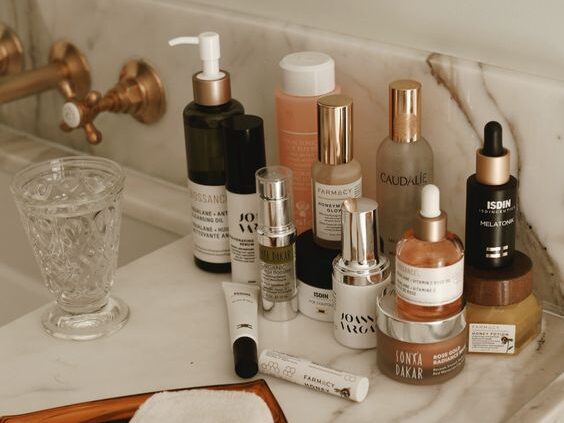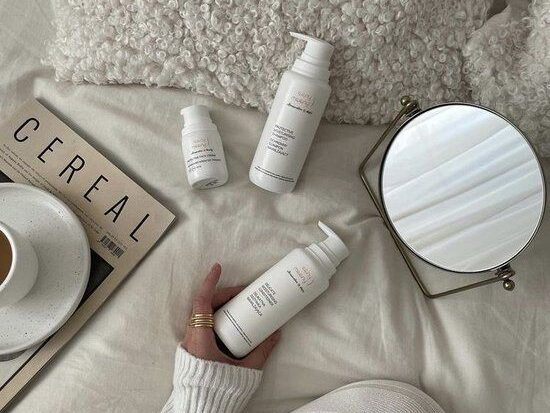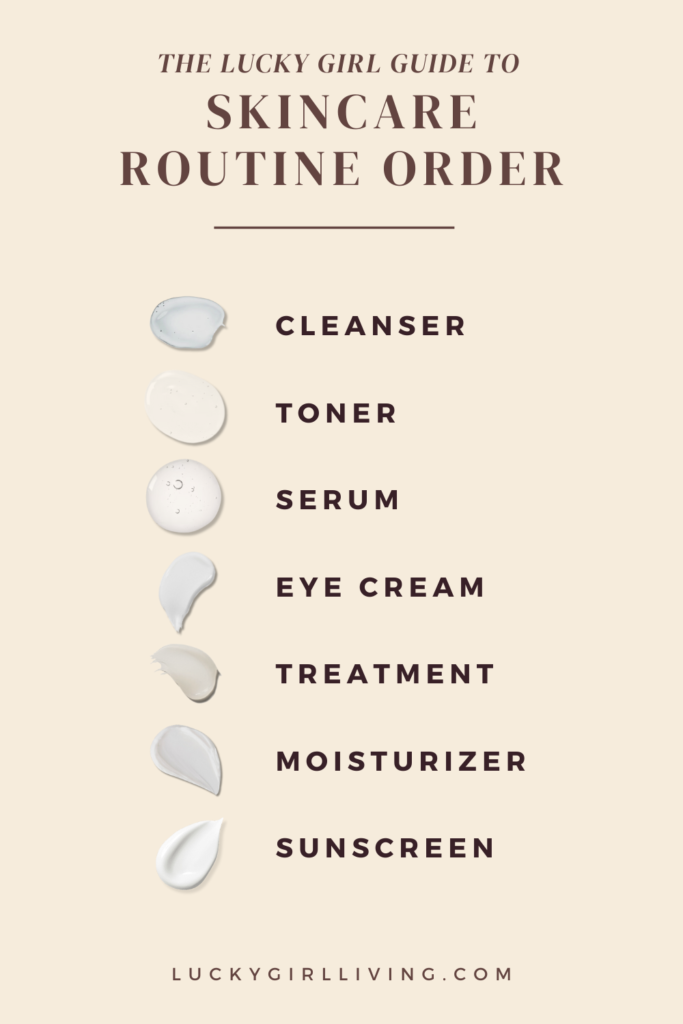We all want to take care of our skin so it is at its happiest and healthiest, but with so many products and ingredients on the market it can get confusing on what to use when and where. It gets overwhelming fast. We’ve put together a foolproof guide to the best skincare routine order for all you lucky girls (or guys, who knows) out there so you can get the glowing skin of your dreams.
This post may contain affiliate links. If you make a purchase through one of my links, I may make a small profit at no extra cost to you. For further information, please view my policies. Thank you for your support!
Why Your Skincare Routine Order Matters
Many of us take a lot of time and spend hard earned money to invest in quality skincare, but if you don’t pay attention to the order of application you may be missing out on the full benefits. Applying your skin care products in the proper order ensures that your skin receives the full benefits of each product by allowing your skin to absorb the products as intended and for maximum effect.
“The order of application is incredibly important. The skin’s job is to keep things out, but many of the skin care products we use have ingredients we want to get in. Only a very small amount of these key ingredients can penetrate the skin, even when perfectly formulated and perfectly applied. If you don’t apply products in the correct order, you will not see the best results from your skin care regimen.”
Dr. Heather Rogers, a board-certified dermatologist and dermatologic surgeon, for Dermstore

Keep It Simple
Human nature is generally pretty straightforward: the more time or brain power it takes to do something, the less likely we are to do it consistently. This is especially true when we are rushing off to work or school or climbing into bed after a long night out. Do yourself, and your skin, a favor and keep your skincare routine simple, if you overcomplicate it you are less likely to stick to it consistently and more likely to aggravate your skin barrier with too many active ingredients. And remember, consistency is key for your skin so find a regimen you know you can maintain as some ingredients like tretinoin can take months or years to see their full effect.
As a final note, listen to your body. If your skin is not loving an ingredient you’re seeing all over social media, it just may not be what works for you. Don’t try to force something into your routine just because it works for others.
How to Layer
The general rule for any skincare routine order is thin to thick. Start with products that need to penetrate the skin like serums or gels and end with products that need to sit on top of the skin like moisturizers or occlusives. If you deviate from this you’re more likely to decrease the efficacy of each product and you may even upset your skin.

The Basic Skincare Routine Order
Below is a basic guide on skincare routine order. It’s a good starting point, but as you learn what works best for your skin you can adapt it as needed to focus on your skincare goals. This could mean simplifying it to just a cleanser, moisturizer, and sunscreen, or expanding it to include occasional masks or peels. This is also not catered to daytime versus nighttime, we will cover these in later posts to delve into how these two can differ and how to best use them to target any skincare concerns you may have.
1. Cleanser
Starting off with the most obvious: a cleanser. Massage your cleanser of choice into your skin with cool water gently for at least 60 seconds to remove makeup or oils you may have picked up from your pillowcase throughout the night. Some people skip using a cleanser in the morning in favor of just cool water, and you could try that as well! If you’re using an oil cleanser or balm to remove your makeup and sunscreen at night, use that before your regular cleanser. It’s great to use cleansers targeted for your skin needs, but remember this will only touch your skin for about two minutes a day. A cleanser can only do so much in terms of treatment.
2. Toner
A toner, if you use one, will always follow your cleanser. If you decide to use one, find one that’s catered to your skin concerns. That could be acne, dryness, or dullness, etc. Toners are more for cleansing than treating, so always use them before essences or other treatments with a water-like formula.
3. Serum
Any serums, essences, or beauty waters would go here. If this if for the morning, we recommend an antioxidant serum to brighten skin and protect your skin from environmental damage like pollutants or UV radiation. If you’re using multiple products, layer them from thin to thick.
4. Eye Cream
It’s best to start using an eye cream in your 20’s to maintain the thickness of your skin as you age and help prevent wrinkles and sagging over time. At night, use an eye cream before any treatments to protect the area from any harsh ingredients that may irritate the delicate skin there. Remember an ounce of prevention is worth a pound of cure, so take care of the skin around your eyes consistently now so it will age gracefully.
5. Treatments
This could be acne spot treatments, anti-aging treatments, or even peels if it’s nighttime. If it’s for acne it’s ideal to get this as close to your skin as possible to avoid any interference with the active ingredients, so you’ll want to limit how many essences or serums are underneath it. Also limit any harsh or drying acne treatments to areas you’re breaking out so you don’t make the rest of your face suffer.
6. Moisturizer
Everyone should use a moisturizer, even if they have oily skin! There are moisturizers out there for every skin type, though generally oilier skin works better with lighter formulas like gels while drier skin can go with thicker creams. When applying, it’s best to pat it into your skin while it’s still damp to lock in hydration.
7. Sunscreen
It may go without saying, but only use sunscreen if it’s daytime. Using sunscreen at night provides no benefits and can even clog your pores, so make sure your nighttime moisturizer doesn’t contain SPF. When selecting a sunscreen, you’ll have to choose between a physical (aka mineral) or chemical sunscreen. Physical uses minerals like zinc to create a reliable physical barrier against UV rays but can leave a white cast, particularly on darker skin tones. Chemical sunscreens use chemicals (duh) to protect your skin from the sun, but will need time to absorb for maximum protection.

Related Posts:


